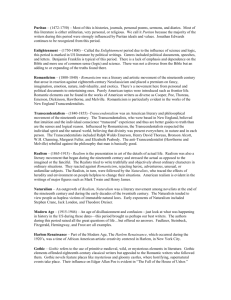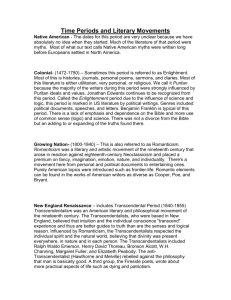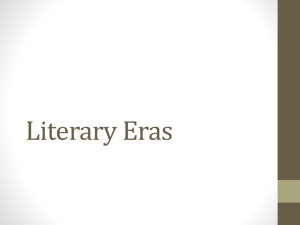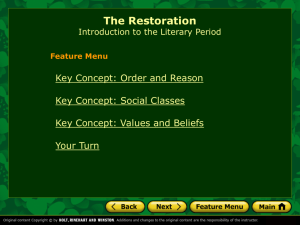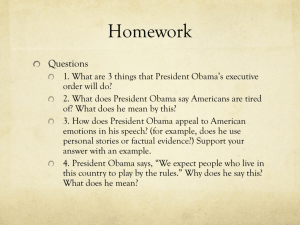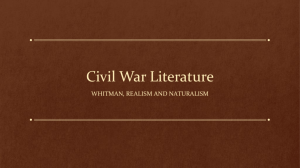Literary Movement Rubric
advertisement
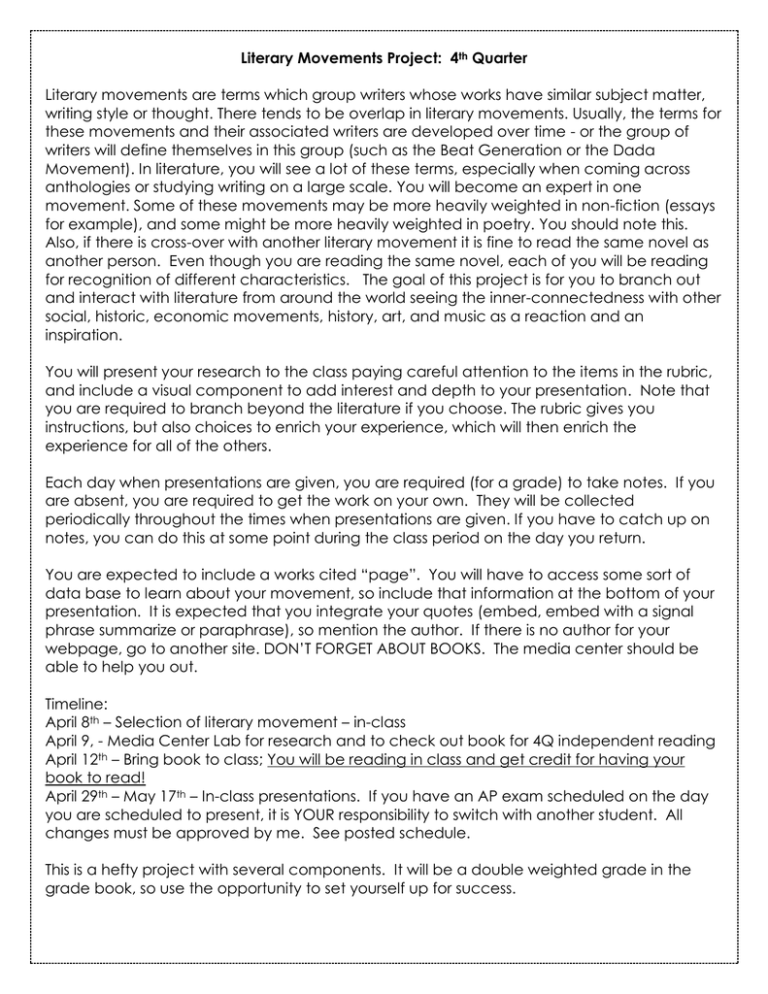
Literary Movements Project: 4th Quarter Literary movements are terms which group writers whose works have similar subject matter, writing style or thought. There tends to be overlap in literary movements. Usually, the terms for these movements and their associated writers are developed over time - or the group of writers will define themselves in this group (such as the Beat Generation or the Dada Movement). In literature, you will see a lot of these terms, especially when coming across anthologies or studying writing on a large scale. You will become an expert in one movement. Some of these movements may be more heavily weighted in non-fiction (essays for example), and some might be more heavily weighted in poetry. You should note this. Also, if there is cross-over with another literary movement it is fine to read the same novel as another person. Even though you are reading the same novel, each of you will be reading for recognition of different characteristics. The goal of this project is for you to branch out and interact with literature from around the world seeing the inner-connectedness with other social, historic, economic movements, history, art, and music as a reaction and an inspiration. You will present your research to the class paying careful attention to the items in the rubric, and include a visual component to add interest and depth to your presentation. Note that you are required to branch beyond the literature if you choose. The rubric gives you instructions, but also choices to enrich your experience, which will then enrich the experience for all of the others. Each day when presentations are given, you are required (for a grade) to take notes. If you are absent, you are required to get the work on your own. They will be collected periodically throughout the times when presentations are given. If you have to catch up on notes, you can do this at some point during the class period on the day you return. You are expected to include a works cited “page”. You will have to access some sort of data base to learn about your movement, so include that information at the bottom of your presentation. It is expected that you integrate your quotes (embed, embed with a signal phrase summarize or paraphrase), so mention the author. If there is no author for your webpage, go to another site. DON’T FORGET ABOUT BOOKS. The media center should be able to help you out. Timeline: April 8th – Selection of literary movement – in-class April 9, - Media Center Lab for research and to check out book for 4Q independent reading April 12th – Bring book to class; You will be reading in class and get credit for having your book to read! April 29th – May 17th – In-class presentations. If you have an AP exam scheduled on the day you are scheduled to present, it is YOUR responsibility to switch with another student. All changes must be approved by me. See posted schedule. This is a hefty project with several components. It will be a double weighted grade in the grade book, so use the opportunity to set yourself up for success. Rubric for literary movement project Content Includes (x5) Academic Approach (x5) Presentation with VISUAL or Electronic Component (x10) Visual, Works Cited page complete and accurate. (x5) 4 All of the criteriaTitle of movement -Title of reading -Characteristics of the movement -Historical Impact -Interconnectivity of movement to particular literary selection -Connection to other movements -Others who wrote during this time -Date of time period 3.5 Most of the criteria is met. 3 Some of the criteria is met. 2.75 Very little of the criteria is met. Characteristics are shared and thoughtful consideration is given to connect to the literature and history. You share the WHAT, AND WHY. You go beyond criteria to share music or art of the era as well, and share that connectivity. All criteria are met: Presentation is ontime, has a VISUAL or electronic component that works, and is 5-6 minutes Characteristics are shared and thoughtful consideration is given to connect to the literature and history. You share the WHAT, AND the WHY. Characteristics are shared & connected to the literature and history. Characteristics are shared, but not connected in any way. Most criteria is met and 4-4:59 min Some criteria is 33:59 min Some criteria are met and the presentation is less than 3 minutes. All are correct Some are correct Few are correct No points for the entire category if no works cited is listed. 1. Absurdist literature c. 1930-1970 This movement occurred primarily in theatre drama. It is nihilistic and emphasizes the meaninglessness of life. One of the most famous works in the Theatre of the Absurd is Samuel Beckett's play Waiting for Godot - in which a pair of men wait for Godot, who never arrives. 2. AESTHETICISM 3. Angry Young Men 1950s-1980s These "angry young men" were a group of British male writers. They created plays and fictional works which illustrated dissatisfaction with their government and the smug middle class. One of the most prominent works in this movement was John Osborne's play, Look Back in Anger (written in 1957). The term was coined by journalists who referred to these writers as such. 4. Beat Generation 1950s-1960s The beat generation emphasized a bohemian culture of sex, drugs, and Buddhism. This generation is often associated with jazz. Allan Ginsberg is a famous Beat poet who gave readings in coffeehouses he wrote the poem Howl. Jack Kerouac's book On the Road coined the term "beat". 5. Bloomsbury Group c. 1906-1930s This informal group consisted of friends and lovers, including John Maynard Keynes, Clive Bell, Roger Fry, Lytton Strchey, Virgina Woolf and E.M. Forster. They lived in the Bloomsbury area of London in the early 20th century, and have a great influence in liberalizing British culture. 6. Commedia dell’arte 7. Dada 8. Enlightenment c. 1660-1790 The enlightenment was a movement throughout Europe which emphasized reason, liberty and technological progress. It is also known as the Age of Reason. Called the Enlightenment period due to the influence of science and logic, this period is marked in US literature by political writings. Genres included political documents, speeches, and letters. Benjamin Franklin is typical of this period. There is a lack of emphasis and dependence on the Bible and more use of common sense (logic) and science. There was not a divorce from the Bible but an adding to or expanding of the truths found there. Most of the writing during this time was nonfiction, such as essays and philosophical treatises by Thomas Hobbes, John Locke, Rousseau and Descartes. 9. Elizabethan era c. 1558-1603 During the reign of Queen Elizabeth I, there was a blossoming of new English drama and literature William Shakespeare being the most prominent. Francis Bacon, Ben Jonson and Edmund Spenser are also some famous writers of this time. 10. Gothic fiction c. 1764-1820 Gothic fiction had mysterious, brooding settings and plots - much like today's "horror stories". Horace Walpole's Castle of Otranto is considered the first major Gothic novel. Edgar Allan Poe's stories are also considered Gothic. 11. Harlem Renaissance c. 1918-1930 Part of the Modern Age, The Harlem Renaissance, which occurred during the 1920’s, was a time of African American artistic creativity centered in Harlem, in New York City. This was a rebirth of AfricanAmerican literature, art and music during the 1920s - beginning in Harlem, New York City. Popular writers of this movement include W.E.B. DuBois, Zora Neale's Their Eyes Were Watching God, as well as the Langston Hughes and Countee Cullen. Other writers of the Harlem Renaissance include Claude McKay, Jean Toomer, and Arna Bontemps. 12. High modernism 1920s Modernism took form in the 190s, but "high modernism" was considered the golden age for modernist literature. This movement broke with the traditional aspects of Western conventions. Popular works during this time include James Joyce's Ulysses, T.S. Eliot's The Waste Land, Virginia Woolf's Mrs. Dalloway and Marcel Proust's In Search of Lost Time. 13. Imagism – Imagism was a literary movement that flourished between 1912 and 1927. Led by Ezra Pound and Amy Lowell, the Imagist poets rejected nineteenth-century poetic forms and language. Instead, they wrote short poems that used ordinary language and free verse to create sharp, exact, concentrated pictures. 14. The Lost Generation c. 1918-1930s The "lost" generation described a generation of writers who had a sense of disillusionment with the world - many of them had just entered maturity during World War I. Prominent writers of this group included F. Scott Fitzgerald, Ernest Hemingway and Dos Passos. 15. Magical Realism c. 1935-present This style of writing combines dream-like imagery and fantasies with real life. Prominent writers included Jorge Luis Borges, Gabriel Garcia Marquez, Gunter Grass and Isabel Allende. 16. Middle English c. 1066-1500 This is the transitional period between Anglo-Saxon and modern English. After the Norman Conquest of England, there was a large amount of new secular literature - including ballads, romances, allegorical poems and religious plays. Chaucer's The Canterbury Tales is a popular book of this period. 17. Modern Age – Modernism – (1915-1946) – An age of disillusionment and confusion—just look at what was happening in history in the US during these dates—this period brought us perhaps our best writers. The authors during this period raised all the great questions of life…but offered no answers. Faulkner, Steinbeck, Fitzgerald, Hemingway, and Frost are all examples. 18. Native American – The dates for this period are very unclear because we have absolutely no idea when they started. Much of the literature of that period were myths, and, of course, the Native Americans still write today. Most of what our text calls Native American myths were written long before Europeans settled in North America. 19. Naturalism c. 1865-1900 This movement used very detailed realism in order to suggest that social conditions, heredity and our environment were inevitable in shaping our human character. An outgrowth of Realism, Naturalism was a literary movement among novelists at the end of the nineteenth century and during the early decades of the twentieth century. The Naturalists tended to view people as hapless victims of immutable natural laws. Early exponents of Naturalism included Stephen Crane, Jack London, Theodore Dreiser, and Emile Zola. 20. Neoclassicism c. 1660-1798 "Neo-" means "new", so this movement was a new version of the classical works of ancient Greece. It emphasized balance and order. Neoclassicism also roughly coincided with the Enlightenment. Popular writers of neoclassicism included Edmund Burke, John Dryden, Alexander Pope, and Jonathan Swift. 21. Nouveau Roman c. 1955-1970 Meaning "new novel", this French movement was led by Alain Robbe-Grillet. One of the lesser known literary movements, Nouveau Roman rid itself of traditional novel elements like plot and character instead, it recording the experience of sensations and things in a more neutral manner. 22. Postcolonial literature c. 1950s-present This involves literature about, or by, people from former European colonies. These colonies include places in Africa, Asia, South America and the Caribbean. Its aim is usually to expand Western literature and challenge the Eurocentric assumptions about race, identity and otherness. Popular works during this time include Edward Said's Orientalism, Chinua Achebe's Things Fall Apart, V.S. Naipaul's A House for Mr. Biswas, and Salman Rushdie's Midnight's Children. 23. Postmodernism c. 1945-present The term "postmodernism" is often used and interpreted in many ways. It is known as a response to the elitist literature of high modernism (such as Hemingway) as well as a response to atrocities of World War II. Postmodern literature is noted for his fragmented use of high and low culture, an absence of tradition and structure and a world of technology and consumerism. Popular writers of this period include Toni Morrison, Vladimi Nabokov, Thomas Pynchon, Salman Rushdie, Julian Barnes, Don DeLillo, and Kurt Vonnegut. 24. Puritan – (1472-1750) – Most of this is histories, journals, personal poems, sermons, and diaries. Most of this literature is either utilitarian, very personal, or religious. We call it Puritan because the majority of the writers during this period were strongly influenced by Puritan ideals and values. Jonathan Edwards continues to be recognized from this period. 25. Realism c. 1830-1900 This term is loosely used - it usually refers to any work that aims to give an honest portrayal (as opposed to sensationalism or exaggeration). Realism technically refers to late 19th century literature that was French, English and American. It aimed to depict ordinary life. Realism is the presentation in art of the details of actual life. Realism was also a literary movement that began during the nineteenth century and stressed the actual as opposed to the imagined or the fanciful. The Realists tried to write truthfully and objectively about ordinary characters in ordinary situations. They reacted against Romanticism, rejecting heroic, adventurous, unusual, or unfamiliar subjects. The Realists, in turn, were followed by the Naturalists, who traced the effects of heredity and environment on people helpless to change their situations. American realism grew from the work of local-color writers such as Bret Harte and Sarah Orne Jewett and is evident in the writings of major figures such as Mark Twain and Henry James. This includes writers such as Honoré de Balzac, Charles Dickens, George Eliot, Gustave Flaubert, and Leo Tolstoy. Naturalism can be considered a more intense version of realism. 26. Regionalism – Another outgrowth of Realism, Regionalism in literature is the tendency among certain authors to write about specific geographical areas. Regional writers like Willa Cather and William Faulkner, present the distinct culture of an area, including its speech, customs, beliefs, and history. Local-color writing may be considered a type of Regionalism, but Regionalists, like the southern writers of the 1920’s, usually go beyond mere presentation of cultural idiosyncrasies and attempt, instead, a sophisticated sociological or anthropological treatment of the culture of a region. 27. Romanticism c. 1798-1832 This literary and artistic movement was a response to the restraints and scientific approach of the Enlightenment. Romantics loved imagination, subjectivity, the romance of nature and spontaneity. Romanticism was a literary and artistic movement of the nineteenth century that arose in reaction against eighteenth-century Neoclassicism and placed a premium on fancy, imagination, emotion, nature, individuality, and exotica. There’s a movement here from personal and political documents to entertaining ones. Purely American topics were introduced such as frontier life. Romantic elements can be found in the works of American writers as diverse as Cooper, Poe, Thoreau, Emerson, Dickinson, Hawthorne, William Cullen Bryant John Greenleaf Whittier, and Herman Melville. Romanticism is particularly evident in the works of the New England Transcendentalists. Popular English writers of the Romantic movement included Jane Austen, William Blake, Lord Byron, Samuel Taylor Coleridge, John Keats, Percy Bysshe Shelley, and William Wordsworth. Greenleaf Whittier. 28. Sturm and Drang 1770s Sturm and drang means "storm and stress/urge" in German. Though this was a brief movement, it advocated great passion - as a response to Neoclassical rationalism. One prominent example is Johann Wolfgang von Goethe's The Sorrows of Young Wether and Faust. This greatly influenced the Romantic movement. 29. Surrealism 1920s-1930s This primarily occurred in France - as you know, Salvador Dali was a popular surrealist painter. There were also surrealist poets, such as Andre Breton and Paul Eluard. These writers were not as popular as the artists of this movement. 30. Symbolists 31. Transcendentalism c. 1835-1860 This was a philosophical (and also spiritual) movement which occurred mainly in New England. It focused mostly on the individual's conscience and rejection of materialism in favor of becoming closer with nature. Thoreau's work Walden and Emerson's Self-Reliance are the most popular works. Transcendentalism was an American literary and philosophical movement of the nineteenth century. The Transcendentalists, who were based in New England, believed that intuition and the individual conscience “transcend” experience and thus are better guides to truth than are the senses and logical reason. Influenced by Romanticism, the Transcendentalists respected the individual spirit and the natural world, believing that divinity was present everywhere, in nature and in each person. The Transcendentalists included Ralph Waldo Emerson, Henry David Thoreau, Bronson Alcott, W.H. Channing, Margaret Fuller, and Elizabeth Peabody. The anti-Transcendentalist (Hawthorne and Melville) rebelled against the philosophy that man is basically good. 32. Victorian Era c. 1832-1901 This era is named after Queen Victoria and ends at her death. She had strict conservative views on sex, religion and science - but during this time, there were a great number of works written, as well as social reform. Writers of this era include Emily and Charlotte Bronte, Anthony Trollope, Charles Dickens, George Eliot, William Makepeace Thackeray and Thomas Hardy. Poets of this era included Robert Browning, Elizabeth Barrett Browning and Alfred Lord Tennyson. Nonfiction writers of this time include Walter Pater, John Ruskin, and Charles Darwin (who wrote The Origin of Species).

